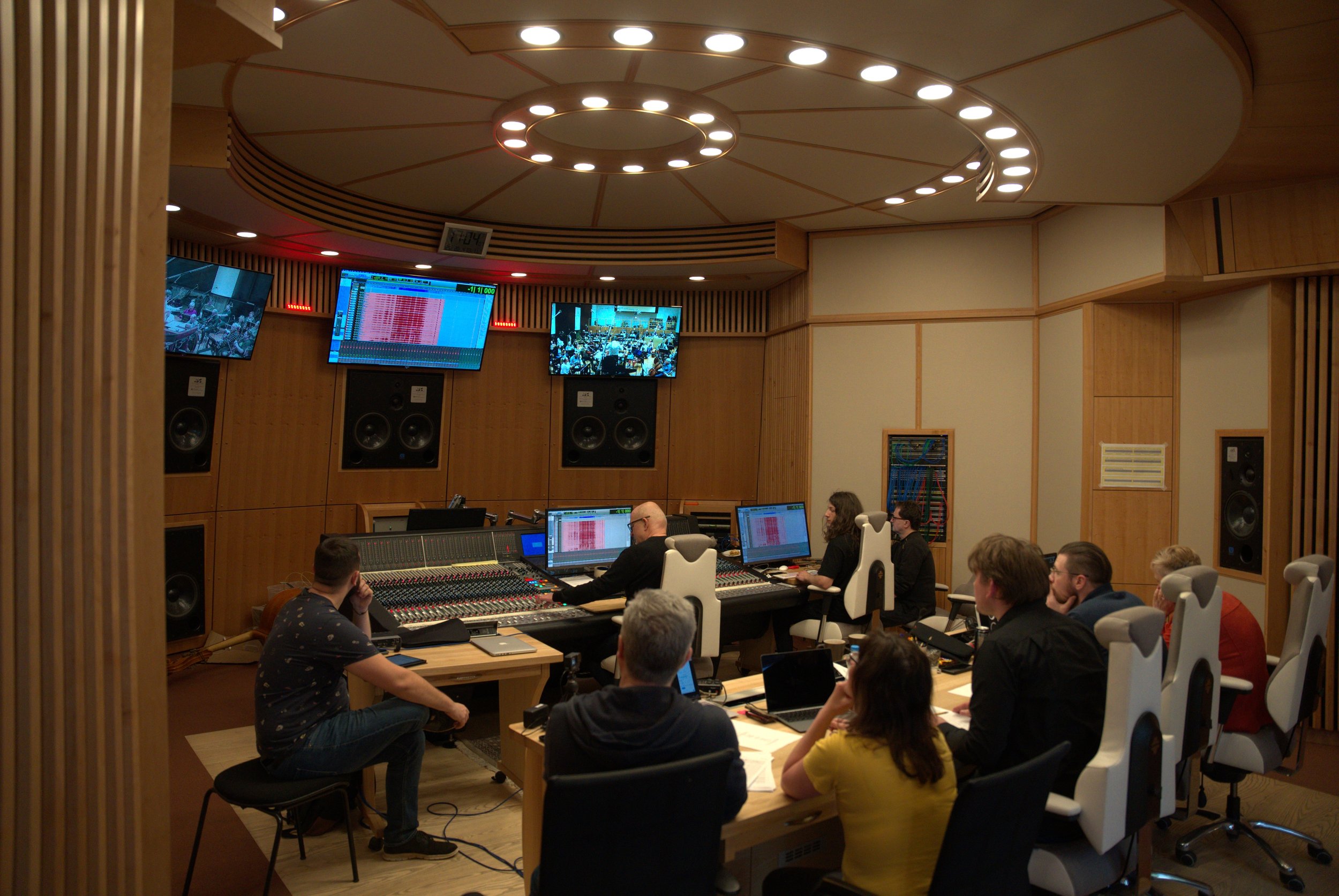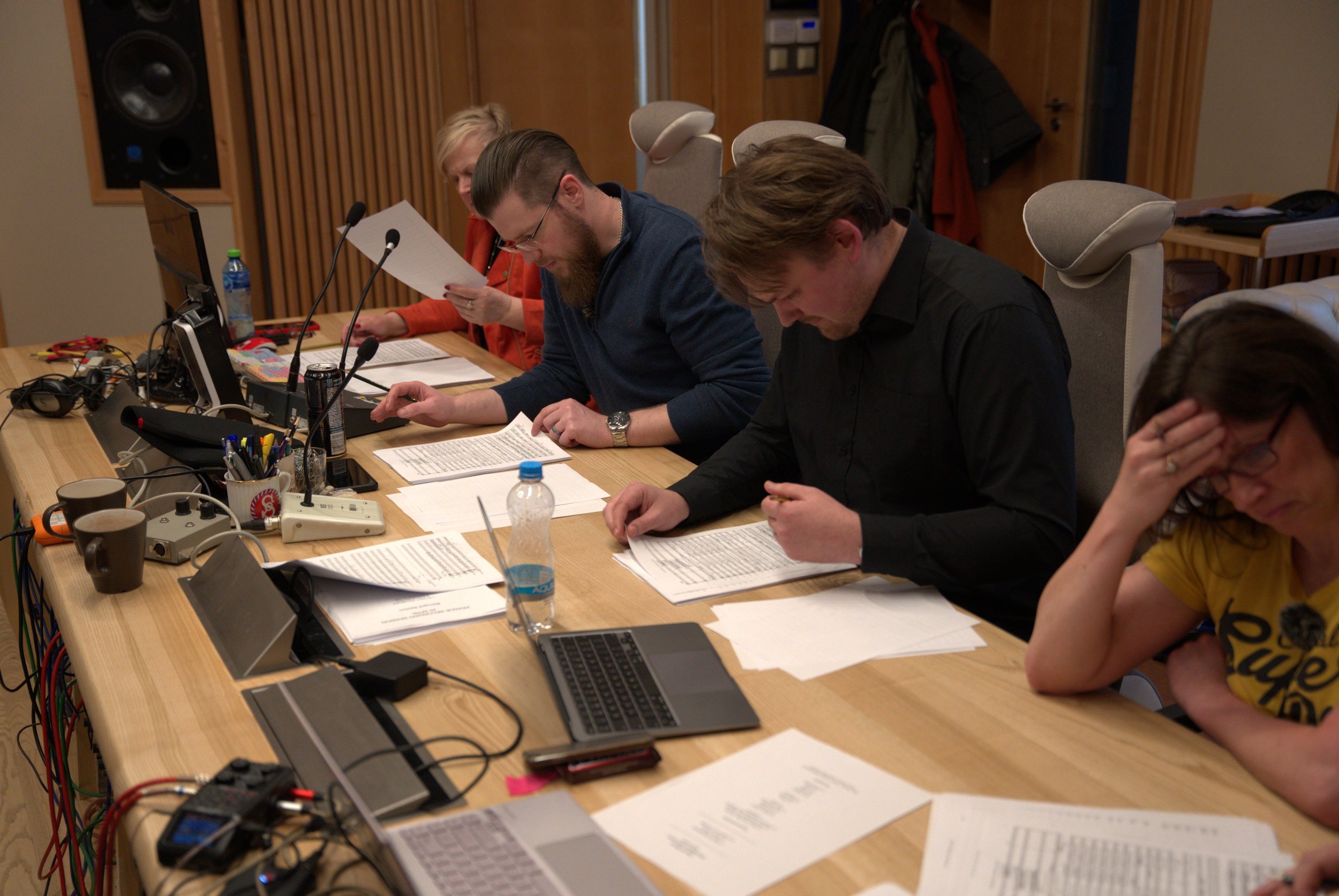Recording Session: Part 2 - The Experience
On Thursday 20th April, I experienced my first recording session with a full orchestra at Smecky Studios in Prague. It was a whirlwind of an experience that was intense but also incredibly enjoyable. I’m still getting my head around the idea that something I composed on my piano at home, was played by 51 musicians in Prague. At time of writing I have just received the audio files from the session, so will be uploading the recordings to my website shortly. Next month’s blog will be comparing the finished recordings with my original mock-ups, but today I’ll be reflecting on the experience and what to learn from it.
This is part 2 of a series on this recording session. Click here for Part 1. Part 3.
The Experience
The recording room in action
Wall of posters in the Corridor between live room and studio
My recording session was part of a shared session with 5 other composers, all having recently finished the ThinkSpace Education Orchestration Masters. We each had just 30 minutes to record everything we wanted. As mentioned in the previous blog, I had planned 3 short cues each about a minute long. I arrived at the Studio at 2pm for the 4 hour afternoon session. The outside of Smecky Studios did not look like a studio! It was on a narrow street, next to a coffee shop. The entrance had 2 big brown doors, and there was a buzzer labelled ‘recepce’ – reception in Czech. Once buzzed through, the opening hall was seemingly fairly empty. It was only when I went up the stairs to the left that I could say with confidence I was in the right place!
The studio had two main rooms:- the live room, which was a big room with a high ceiling that hosted the orchestra, and the recording room. This was bigger than I expected; it had 3 screens – 2 live feeds to the live room, and a central screen containing the current pro tools session. Above these screens was a clock, which I felt very aware of during my session. In the main body of the room there were two rows of desks, one for the Pro Tools operators, and one at which I eventually sat. My 30 minutes started at 5pm, allowing me the chance to listen to a few of the others, and really get to grips with what to expect. I had a chance to sit both in the recording room and also the live room, which was particularly spectacular – you don’t often get chances to listen to an orchestra while seated only a few metres away from the 1st violins!
When 5pm arrived, it all went very quickly! I had about 10 minutes on each cue, which amounted to 11 takes overall. 4 on the first cue, 4 on the second, and 3 on the last cue, so not much room for error! I also had a chance to conduct the last cue of my session, an experience which gave me huge appreciation for the main session conductor, Adam Klemens.
Lessons Learnt
Musicians and Conductor
One of the overriding feelings I had coming out of the session was just how impressive the musicians and conductor were. They spent pretty much the whole 4 hour recording session, excluding two 15 minute breaks, sight reading. As you’ll hear in the next blog, their playing brought high quality, expression, and real life to my 3 pieces. Something that particularly stood out to me were the solo sections in my pieces. Particularly the woodwind solos in ‘Call To Adventure’. As a result, the next time I get the chance to write for real instruments I really need to make the most of this!
Another thing I discovered, in particular for Call To Adventure is not to push the woodwind section too hard. As mentioned, the piece features woodwinds heavily, and initially I felt they were getting drowned out by the strings (despite the strings playing pretty quietly). My thought process was to ask the woodwinds to play louder, but this led to overblowing, resulting in a loss of tone. It is vital to allow the musicians to play in their instrument’s sweet spot, both in volume and range. The more you venture out, the less you are going to enjoy the end result – unless that’s the effect you are going for! Looking at the audio files I’ve just received, the overall solution to this problem is to fix it in the mixing stage, and to be honest they don’t really need that much boosting at all.
The Score
As mentioned in the previous blog, it was vital that the score was presented in a clear fashion, easy to read, with as few ambiguities as possible. I was pretty happy with how my scores turned out, and how they were interpreted. There weren’t any questions from the musicians, and overall only one misunderstanding out of all the 3 cues! Considering I only had 10 minutes for each cue, this time saved was invaluable.
Percussion Score of Starry Skies from bars 51-58
To address that one misunderstanding, it happened in my second cue ‘Starry Skies’. On bar 54 to 55, I had indicated a Cymbal roll and had tied it to the start of bar 55. The percussionist interpreted this as asking for an extra hit at the start of bar 55. It ended up being a very easy correction but did cost a take.
Something I will take away for next time is the power of the performance directions such as molto vib. and expressivo, particularly for the String section. It can really highlight the climactic moments of your piece, and gives license for the musicians to play out. There’s a section towards the end of Call To Adventure which was hugely improved once we asked the String section play expressivo.
Deep concentration!
Be Confident!
It is really important to be confident with your musical intentions. During my session I had a momentary doubt about how I had marked the climax in ‘Starry Skies’. I had chosen rit, and at that point felt it important to mark molto rit instead. The moment I said this, I immediately regretted it. It led to the translator and conductor and all the musicians flicking through their music to make the correction, and delayed the start of the first take. Ultimately, I should have had more confidence in the score I had spent many hours preparing.
During this same cue, at the suggestion of one of the ThinkSpace tutors, Tim Johnson, we also took the decision to do a take without the click. This is something I hadn’t even considered, but ultimately led to the best take of the cue. Not using a click is a risky strategy, and sometimes completely impractical if scoring directly to screen. The danger is that you can’t comp during the mixing stage (combine several cues into one recording). But the benefit of making this decision is that it led to a much more musical performance, particularly the pause at the end of the climax. This whole situation came about through Tim’s confidence to suggest it, and is something I aim to learn and incorporate in the future.




